I have been posting photos of various neighborhoods and buildings in Toronto, mostly with a positive and admiring stance. I cannot take photos of "negative" things, i.e., ugly things. That might be a weakness, but that is my attitude.
The interesting thing is that almost all my photos of the (beautiful) landmarks, buildings and sites depict a historical Toronto, not a current one. This dawned on me when I was taking photos of the Toronto Dominion Center complex, designed by the architect Mies Van der Rohe, which is the only contemporary building I have photographed. I find the complex imposingly beautiful, grand and the very best of skyscraper architecture of the 1960s. I juxtapose these photos with those of the insipid high rise of the CIBC center (they are next to each other), designed by the Chinese I. M. Pei only a decade later in 1973. I took photos of Pei's building, and posted them only to compare and contrast these two buildings, both contemporary, yet one far superior than the other. In fact, I contrast Pei's building with the original CIBC headquarters building of 1931 to show the paucity in Pei's design. The Van der Rohe complex is one of the few contemporary buildings in Toronto which has a grand presence, but it is an anomaly rather than the norm.
Something happened to make Canada (and by extension, Toronto) a mediocre and second-tier place, as demonstrated by the architecture. I think it has to do with the British influence, where Canada was regarded as an outpost to counter the formidable American presence to the south, rather than a place to develop and build. Genteel Victorian houses dominate in the major cities, where British colonists lived and oversaw the rule of the country. But frontier towns and regions, especially in the Niagara/New York state area, have fortified complexes to ward off American incursions.
There is also the ever-present French animosity, which affected nation building. But the whole of Canada is in some form of break-away state, from Quebec to Western Canada, and even the Atlantic coast Maritime provinces. This lack of national cohesion is subtly and constantly felt, and art and architecture capture this ambivalence. And although there were impressionable edifices erected during the formal British presence, they are far and few between to make a strong cultural contribution.
I'm at an exploratory phase with these ideas. When did Toronto become a second-tier city? Was it always a second-tier city, and if not, why did it slide down the excellence scale?
More on that later.
----------------------------------------------------
Posts at Camera Lucida on Toronto architecture can be found under the Architecture label, going as far back as 2005.
Sunday, October 30, 2011
Thursday, October 27, 2011
Review of Bat Ye'or's new book Europe, Globalization, and the Coming of the Universal Caliphate
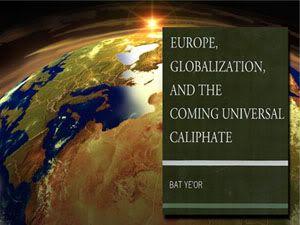 |
Here's my review of Bat Ye'or's new book Europe, Globalization, and the Coming of the Universal Caliphate.
---------------------------------------------------------------------
Bat Ye’or, author of Eurabia: The Euro-Arab Axis, has published a new book titled Europe, Globalization, and the Coming of the Universal Caliphate. It is a concise, five-chapter book, and the contents mince no words. "The Destruction of the Nations of Europe" is ominously the final chapter. And the link between Europe and Islam is under the chapter "The European Union and the Organization of the Islamic Conference: A Common Struggle." There are two chapters on multiculturalism, one simply titled "Multiculturalism," and the other "Multiculturalism, the OIC and the Alliance of Civilizations."
The general theme of the book is the European link with Islam, and how many stages of Islam’s presence in Europe were aided and abetted by the policies and directions of European governments and leaders.
Eurabia is a term coined by Bat Ye’or, and she explains this concept fully in her book. Under the subtitle: "The Origin of Eurabia," Ye’or paints a frightening picture of former Nazis collaborating with Muslim leaders to enter and influence the infrastructures of European society and politics under a Muslim and Arab body. One of these earliest associations was initiated in 2002 under The Euro-Arab Dialogue, which formalized agreements between the European Economic Commission and countries in the Arab League that were made as far back as 1973. But, the history goes further than that, when Nazi antisemitism was supported by the Arab world, and Hitler actively sought the alliance of Muslim countries in his (and their) quest to annihilate the Jews.
Bat Ye’or writes in Europe, Globalization, and the Coming of the Universal Caliphate:
...in Islam peace only exists between Muslims, and not between Muslims and non-Muslims5. The word “peace” applied to non-Muslims requires conversion or submission (dhimmitude)…striving in the path of Allah to spread Islam in the world is not war but a pious, just action and a religious duty.Islam is not only a religious concept, but a warrior one as well, where the world’s non-believers (non-Muslims) are brought to Allah through armed jihad. The world has always belonged to Allah, and those parts that were taken away over the centuries have to be returned to him, hence the argument for violent wars against “infidel” territories, who blaspheme against Allah but who can receive eternal blessing and salvation once they and their people return to Islam.
Under the heading "The Centrality of Israel in Islamic-Christian Relations" Bat Ye’or clarifies what is the common bond that binds Muslims and Christians and of course Europeans: the hatred of Jews and of Israel. The tactic Muslims have used to bring Christians to their fold is through the dejudaization the Bible. There is no tactic for Jews, as Mohammed has clearly delineated, only death. Bat Ye’or once again references Europe’s darkest hour, Nazism, to show this bond between Islam and a Europe without its Christian roots. She writes:
The policy of dejudaization of Christianity is not new. Based on prejudice and ignorance of Judaism, it reached in paroxysm in Nazism and served as a binding force between, on the one hand, Nazis and antisemites in Europe, and on the other hand, their faithful allies in the Muslim world – including the Arab Churches and Christian Arabs, particularly Palestinians.Modern Europe continued with this antisemitism and Muslim collaboration through a clever strategy of immigration. Hypocritical leaders chastised, and won over, their populations by labeling aversion to immigration as racism, and that it is equal to the evil of the antisemitism that led to the death of thousands of Jews only a few decades ago.
Europe’s pact with Arabs was sealed in 1973 through the European Community (precursor to the European Union). Persistent terrorist attacks in European cities by Palestinians, and the OPEC oil boycott broke the European front, and the leaders made a deal with the Muslim world to recognize the PLO, to side with the Arab world against Israel and the United States, and to allow unrestricted Muslim immigration into Europe to dampen European nationalistic movements. The Muslim lands would in turn quell the terrorist attacks and give Europeans access to their oil. The Iraq war in 2003, President Bush’s "war on terror" campaign, prompted fresh anti-American and anti-Israeli sentiments, with renewed Euro-Arab pacts, including strengthening ties with the PLO.
One of the most frightening revelations of the book is the collaboration of European nations with former Nazi Germany officials who had "recycled themselves in influential positions in postwar European society...The war against the Jews waged in World War II did not stop in 1945, for its ideology and tactics continued through other channels converging in Palestine," writes Bat Ye’or.
The policy of open immigration of Muslims into European countries led to the most amorphous effect of the Arab-European pact, which manifested itself into a policy of multiculturalism. But, Muslims and Arabs refused to be integrated into European society, creating pockets of their culture within the cities they inhabited. Rather than confront this, the history of multiculturalism in Europe has been to find ways to circumvent this refusal and still allow such alien cultures to live in their societies. Islamic customs, holidays, dress-codes and law were accorded an equal footing with those of their host countries. “Diversity” was coined to accommodate these cultural impasses. This precipitated “The destruction of the nations of Europe” as Bat Ye’or titles her penultimate chapter, which amongst other elements, has allowed totalitarian, anti-diverse, anti-multicultural Islam to flourish, and the ever-growing Muslim population, now several generations old, to expand and destroy the centuries-old European civilizations.
The "networks of global governance" – the Islamic Caliphate – are now in place. Bat Ye’or concludes:
In the twenty-first century we are reliving a replica and restoration of the Islamic Caliphate of the seventh century, through approval and pliability of Western leaders. One might compare these demands on the West with Article 23b of the Cairo Declaration on Human Rights in Islam, which stipulates:Everyone shall have the right to participate directly or indirectly in the administration of his country’s public affairs. He shall also have the right to assume public office in accordance with the provisions of shari’a.
Wednesday, October 26, 2011
Freaky Chaz Bono kicked off Dancing With The Stars
 |
I don't mean this blog to be a Dancing With The Stars news feed, but ever since I heard that the transexual/transgendered/lesbian/freak Chaz Bono was going to be on the show, I've waited for it to be eliminated. I think the audience freak factor votes kept it going for this many weeks, but FINALLY, IT'S GONE! But of course, this boot off the floor became the perfect moment for Bono to make a pitch. "I wanted to show America a different kind of man." was its exit line.
Now I can watch with admiration the truly talented professional dancers, and the long and arduous training the stars endure, making those that get to the top five almost on a par with their teachers/dance partners.
Of course, some professionals are better than others, but Lacey Schwimmer (who regularly dances with her brother Benji), Chelsea Hightower, Julianne Hough (who's brother - DWTS is a family affair - I wrote is a modern version of Fred Astaire) and Kym Johnson are really great dancers (links are to videos). Their graceful waltzes and energetic quicksteps bring ballroom dance to its artistically beautiful level. Some dances are a little racy, and some of the costumes a little too revealing, but this is television (and showbiz).
Now that I've watched the show for so long, I'm getting better at comparing the good dance moves (and the good dancers) with those that somehow wing it. I don't know how this "professional" has made it on the roster for all these seasons.
According to this "judge" it is Hope Solo who dances like a man. I disagree. Admittedly, Hope has stronger muscles than the other women, she is after all an athlete, but she looks pretty and feminine on DWTS, and she's nothing like Bono, who receives accolades from this judge despite ending up at the bottom almost every week. It is, of course, the usual politically correct, pseudo solidarity with the different, "a different kind of man." To judge the Bono's creepiness would be to discriminate. And we just can't do that, can we?
Tuesday, October 25, 2011
Outsourcing the Perfume
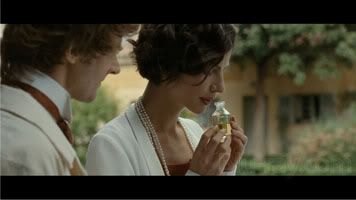 |
I wrote yesterday about the aggressively ugly clothing designs of Martin Margiela, but was surprised at his perfume's subtle, pretty scent (despite its unimaginative "avant-garde" bottle and name).
I looked up the "perfumer" of the scent, since he is often different from the designer who puts it under his label, and sure enough it is Daniela Andrier, who also creates the successful Prada perfume line.
This is becoming a common trend in fashion design, where different aspects of the line (usually not related to the clothing) are outsourced to other designers. But, this wasn't always the case. Chanel was intricately involved in the creation of her famous, and most successful, perfume, No. 5. Interestingly, No. 5 was also the "clinical" label of the final test tube sample that would be her perfume.
Above is a scene from Coco Chanel and Igor Stravinsky. Chanel is smelling sample vial No. 5 with her "clinician" at her at her perfume lab. This is the sample she chose for her famous perfume, which she named after the vial's number. The ingredients were under her specifications, which she modified with her assistant, and included roses cultivated at the famous flower farm in Grasse.
Monday, October 24, 2011
Fresh for Spring
 |
Christmas is not even close, but designers are already thinking about spring.
Here's a fresh, mild scent that really is just right for spring. (untitled) l'eau, yes, that's the name of the perfume and the way it is presented on its clinical flask, is by Martin Margiela, a fashion designer I knew nothing about. The perfume reminds me of Lancome's O de Lancome, another fresh, light scent, but I think Margiela's concoction is subtler and sweeter.
Below is Wikipedia on Margiela:
During the 1980s, the Japanese avantgardists, with Rei Kawakubo—creator of the label Comme des Garçons—had turned the fashion scene upside-down with their eccentric and ground-breaking designs. Martin Margiela and the Antwerp Six would carry on the work, revolting against the luxurious fashion world with garments of oversized proportions such as long arms, and with linings, seams and hems on the outside. The concept of deconstruction, also embraced by the aforementioned Rei Kawakubo, is important for the understanding of Martin Margiela's fashion statement. Margiela famously redesigns by hand objects such as old wigs, canvases and silk scarves into couture garments.Margiela's fashion design isn't that avant-garde. It is quite bland actually (here is his website, a strange design concept which looks like we are accessing his files).
But despite these "avant-garde" inclinations, he has produced a pleasant scent, light and fresh, just in time for the spring that is only five months away!
Here's what Pure Beauty has to say about this new fragrance, launched in 2011:
Maison Martin Margiela (untitled) l’eau retains the radicality of the original untitled fragrance while opting for a new olfactory approach; while the original features the cool green notes of galbanum, the new scent celebrates citrus aromas. An unusual double distillation process is applied to mandarin orange and lemon, as well as crushed leaves, while curly leafed mint and essential oil of buchu underscore the scent’s rich green character. The handcrafted bottle wears the signature code of Maison Martin Margiela, the emblematic white with a trace of paint. The fragrance itself is a transparent green.And more from here:
This fragrance manages to refine itself with a lime green undercurrent swished with ice cool mountain brooks. It deftly manages to combine cutting edge modernity with a notion of good old fashioned clean Spring like images, spurning floral bases and concentrating on the cool, sparkling appeal of a Summer scent. Mandarin orange and lemon are added to crushed leaves with mossy accents while a hint of mint and essential oil of buchu penetrates through the composition which relays subtle femininity.
Sunday, October 23, 2011
Canada: An Amalgam of Mediocrity
Please excuse the length of this blog. It is a descriptive piece, although I do get into some analysis and my perspective near the end.
I started to write a positive review of the National Ballet School and its buildings, but I needed more information and had to return to the site to find out more. And that's when I changed my mind about the positive review, and decided to write it with the negative stance that I had tried to ignore in my initial observations.
The complex takes up two areas of downtown Toronto. See the map below:
There is a mixture of old Victorian buildings and modernist (postmodernist) glass boxes. Many of these buildings are named after former National Ballet dancers or philanthropists, and I wanted to get their names and contributions right, so I went to the sites for more information.
The first time I went to ask about a building called "The Shoe Room" I was met with an administrator who took my questions as some form of KGB interrogation, and made it clear she wanted me out as soon as possible. I reacted strongly, and said I was merely a Toronto resident interested in the culture and arts of the city. I left forgetting to get the most important information, which was on the ballet shoes left by famous (at least by Canadian standards) dancers on display at The Shoe Room.
Then I went next door to the glass high rise and asked more questions. This time, I was voiced my surprise that so many buildings make up this school, and asked about the name and function of this particular building. The front desk woman responded in the same rude, dismissive manner. And that is when I lost my temper. She backtracked and said that they have to "protect the girls," an insulting answer which implied that I was out to get these girls, like some pedophile child molester. I left perplexed at this behavior.
I went around the corner to the adjacent complex of buildings on Maitland Street (see map above) to find out more about the names of buildings and architectural styles in this complex. The woman there was more obliging, but she was not part of the NBS, having rented out the hall for another function.
I went next door to yet another NBS complex, and once again, the woman at the reception made it clear without mincing her words that this was the "girls' residence" (are there no "boy" dancers, and where do they stay?), and that I had to leave. Again, I was labeled a potential pedophile in no uncertain terms.
I took photos of this building, and decided to find out the information online. But that wasn't much help, so I decided today to finish off this project I had started to find out more about this important cultural center, close to my home, and which I pass by almost daily.
This morning, I reluctantly set off again to fill in the missing gaps.
I asked once again the woman (another one, this time) at the reception desk at the high rise complex my usual, simple questions: name of the building, and function of the building. The woman responded in the same rude and dismissal manner as all the others. Then I said (paraphrasing): "Look, Madam, I am asking simple questions about an important cultural center. There is no need to speak to me in that rude manner." Then, having nothing left to do, the women said, "You have to leave the building please." I was expecting some reaction, so I said, "I will tell everyone I know not to come to the National Ballet school, that the dancers are not all that good, and the shows are not worth their price. And to my non-Canadian friends, that Toronto is an unfriendly city and not worth the visit ." I said this in front of young dancers coming in for their classes, loudly and clearly. Then I left.
I was followed by a "security guard," a dark-skinned Third World immigrant who is participating in this subtle policing that is becoming common in Toronto these days. I told him that I did nothing wrong, but he replied that he didn't think so. "What have I done, then?" I asked. "You cannot take photos of the girls," came that odd reply. By this time, I was really furious, and told hem that he can go back inside to his stupid little job. He lingered, watching me. I could have called out "pervert on the loose" and found a real policeman.
Still, I had set out to do more than getting entangled with this bizarre situation. So, I went around the corner to verify information about the school's other complex. Another dark-skinned, Third World immigrant had been sent out to "keep an eye" on me. I gave him a scornful look, took my photos away from the "property" of the school, and left.
Here is the email I sent to a "to whom it may concern" in the "contact us" page of the NBS website (a generic box to fill in and submit):
Currently, the ballet has a foreigner as a principal dancer, but this happens to be a Chinese-trained female dancer. I doubt that any American ballet company would want her. Imagine watching Swan Lake performed by a Chinese dancer? How are these young NBS dancers, guarded so strongly by these women as though they have brittle bones that could break at a glance, supposed to reconcile the story of Swan Lake with a Chinese face? How is that "protecting" young Canadian dancers?
I tried to find out about more about the Chinese dancer, Xiao Nan Yu. Whether she was married to a white Canadian as is becoming the norm here in Toronto, how she got into Canada in the first place, etc. Here is an excerpt of her biography from NBS website:
I searched for her family background, since she has photographs of her with an Asian-looking daughter on her NBS profile. I was actually looking to see if she married a white Canadian once in Canada. But this website briefly mentions her marital situation:
Part of the ballet school houses the training rooms for the young dancers. These training rooms are in the taller building made of glass, and the students practicing, rehearsing and training are in full view of pedestrians below.
Is this the way to "protect" young girls, who can be the prey of lurking (real) pedophiles and sex criminals watching and waiting from below?
Here's what the NBS informs us about one of the buildings, The Margaret McCain Academic Building:
Barely visible on the taller highrise is:
Sculptures of a swan and a cherub are at the front entrances of a couple of these buildings. The title for this series of sculptures of swan and cherub in various poses is "Desire." One of my question for these hapless receptionists was, "why desire?". Having received no answer, I can deduce that the swan desires the cherub. So who's the pedophilia now! In fact, all the other works of Tom Dean, the sculptor of this series, are dark and macabre. Here's one titled "Sloth" displayed at the Edward Day Gallery. Here's how the gallery describes Dean's work:
Finally, the head architect of the firm that designed the building (if one goes by the name sequence of their firm, and the distanced stance of the man on the far left), is an Asian. A final knot that ties together Asian triumphalism with mediocrity, and the West's infatuation with all thing Asian.
I was looking forward to showcasing some of Toronto's cultural buildings. I wondered at the rude behavior of these women. I think it is surprise at a non-white person showing interest in high, Western, culture. Third World immigrants are not supposed to act "white" and have interest in ballet, opera, concerts, art and architecture. They are supposed to stay in their quaint, exotic enclaves, practicing their quaint, exotic culture (as far away from us as possible), leaving us only safe vestiges of their colorful clothes and spicy (not too spicy) foods.
But, I showed up in my Western clothes, dressed in a salmon/tan coat with matching tan hat and scarf, and white woolen gloves, looking far smarter than the white liberal Third-World-wannabes that roam our streets in their ugly clothes, and middle-aged women (like the receptionists at the NBS) in sloppy pants and shapeless sweaters who would put to shame their grandmothers who took such care with their appearances. That triggered their wrath. "How can a Third Worlder look better than us?" I really think is their rage. At the end of the day, for all their talk of "equality," they simply want these Third Worlders under their thumb, looking pathetic (and worse, and worse off, than them), begging for crumbs. That way, they can pour on them all the "good will" that they can muster, and feel good about themselves. And let's not forget the conveniently located exotic restaurants where the food is not too spicy, where they can "participate" in all the wonderful (at a distance) cultures of the (Third) world.
Architecture, art, culture and society have converged to give us mediocrity. And Canada is the perfect example of this amalgam.
---------------------
I started to write a positive review of the National Ballet School and its buildings, but I needed more information and had to return to the site to find out more. And that's when I changed my mind about the positive review, and decided to write it with the negative stance that I had tried to ignore in my initial observations.
The complex takes up two areas of downtown Toronto. See the map below:
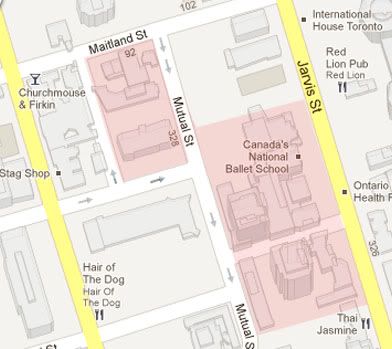 |
There is a mixture of old Victorian buildings and modernist (postmodernist) glass boxes. Many of these buildings are named after former National Ballet dancers or philanthropists, and I wanted to get their names and contributions right, so I went to the sites for more information.
The first time I went to ask about a building called "The Shoe Room" I was met with an administrator who took my questions as some form of KGB interrogation, and made it clear she wanted me out as soon as possible. I reacted strongly, and said I was merely a Toronto resident interested in the culture and arts of the city. I left forgetting to get the most important information, which was on the ballet shoes left by famous (at least by Canadian standards) dancers on display at The Shoe Room.
Then I went next door to the glass high rise and asked more questions. This time, I was voiced my surprise that so many buildings make up this school, and asked about the name and function of this particular building. The front desk woman responded in the same rude, dismissive manner. And that is when I lost my temper. She backtracked and said that they have to "protect the girls," an insulting answer which implied that I was out to get these girls, like some pedophile child molester. I left perplexed at this behavior.
I went around the corner to the adjacent complex of buildings on Maitland Street (see map above) to find out more about the names of buildings and architectural styles in this complex. The woman there was more obliging, but she was not part of the NBS, having rented out the hall for another function.
I went next door to yet another NBS complex, and once again, the woman at the reception made it clear without mincing her words that this was the "girls' residence" (are there no "boy" dancers, and where do they stay?), and that I had to leave. Again, I was labeled a potential pedophile in no uncertain terms.
I took photos of this building, and decided to find out the information online. But that wasn't much help, so I decided today to finish off this project I had started to find out more about this important cultural center, close to my home, and which I pass by almost daily.
This morning, I reluctantly set off again to fill in the missing gaps.
I asked once again the woman (another one, this time) at the reception desk at the high rise complex my usual, simple questions: name of the building, and function of the building. The woman responded in the same rude and dismissal manner as all the others. Then I said (paraphrasing): "Look, Madam, I am asking simple questions about an important cultural center. There is no need to speak to me in that rude manner." Then, having nothing left to do, the women said, "You have to leave the building please." I was expecting some reaction, so I said, "I will tell everyone I know not to come to the National Ballet school, that the dancers are not all that good, and the shows are not worth their price. And to my non-Canadian friends, that Toronto is an unfriendly city and not worth the visit ." I said this in front of young dancers coming in for their classes, loudly and clearly. Then I left.
I was followed by a "security guard," a dark-skinned Third World immigrant who is participating in this subtle policing that is becoming common in Toronto these days. I told him that I did nothing wrong, but he replied that he didn't think so. "What have I done, then?" I asked. "You cannot take photos of the girls," came that odd reply. By this time, I was really furious, and told hem that he can go back inside to his stupid little job. He lingered, watching me. I could have called out "pervert on the loose" and found a real policeman.
Still, I had set out to do more than getting entangled with this bizarre situation. So, I went around the corner to verify information about the school's other complex. Another dark-skinned, Third World immigrant had been sent out to "keep an eye" on me. I gave him a scornful look, took my photos away from the "property" of the school, and left.
Here is the email I sent to a "to whom it may concern" in the "contact us" page of the NBS website (a generic box to fill in and submit):
To whom it may concern,I was serious about the quality of the school and of the ballet company. It is a second tier performance group, and even Baryshnikov, who defected from the Soviet Union to Canada in 1974 and was given asylum in Toronto, preferred to leave for the United States, joining the New York City Ballet and on to a prestigious career post-Soviet Union.
This morning, Sunday October 23 around 10:30am, I was at the National Ballet School, inquiring about the school, and the various buildings that make up the school.
I was met with a hostile receptionist, who wanted me out of the building as quickly as possible.
When I confronted the middle-aged woman about her rudeness, she called security, and threatened to "call the cops."
Her response was rude, unexpected, and unacceptable. I told her as such.
This caused her to tell me to "leave the premises" or otherwise she would "call the cops."
I left, with a security guard hovering behind me.
Please take care of this situation, namely the behavior of the receptionist. I expect an apology from her.
Please let me know of the outcome of your investigation, since I intend to take this incident to whatever level required in order to have an apology from your institution.
Kidist Paulos Asrat
Currently, the ballet has a foreigner as a principal dancer, but this happens to be a Chinese-trained female dancer. I doubt that any American ballet company would want her. Imagine watching Swan Lake performed by a Chinese dancer? How are these young NBS dancers, guarded so strongly by these women as though they have brittle bones that could break at a glance, supposed to reconcile the story of Swan Lake with a Chinese face? How is that "protecting" young Canadian dancers?
I tried to find out about more about the Chinese dancer, Xiao Nan Yu. Whether she was married to a white Canadian as is becoming the norm here in Toronto, how she got into Canada in the first place, etc. Here is an excerpt of her biography from NBS website:
Born in Dalian, China, Xiao Nan Yu trained at the Shen Yang School of Dance, the Beijing Dance Academy in China and Canada’s National Ballet School. She joined The National Ballet of Canada in 1996 and has been a Principal Dancer since 2001.Here are photos of her from the NBS site. Note her aggressive expression. And her official portrait at the NBS website shows a hard glint in her eyes, the triumphalist Asian behavior that I'm observing in Asians (here are my blogs on designers Wang and Doo-Ri). Here is Yu dancing the role of Odette in Swan Lake, an Asian face in a Western role.
I searched for her family background, since she has photographs of her with an Asian-looking daughter on her NBS profile. I was actually looking to see if she married a white Canadian once in Canada. But this website briefly mentions her marital situation:
Xiao Nan Yu, principal dancer with The National Ballet of Canada, and her husband Shuang are the proud parents of a baby girl named Ava, born in November.The daughter is given the convenient English name of Ava (as in Gardner?!). Yu may not have her "Canadian" life, but she will make that easier for her daughter, including making it easier for her to nab that white Canadian husband.
Part of the ballet school houses the training rooms for the young dancers. These training rooms are in the taller building made of glass, and the students practicing, rehearsing and training are in full view of pedestrians below.
Is this the way to "protect" young girls, who can be the prey of lurking (real) pedophiles and sex criminals watching and waiting from below?
Here's what the NBS informs us about one of the buildings, The Margaret McCain Academic Building:
8 academic classrooms; laboratories for computer, science and photography studies; art studio; audio-visual room; music room; ESL room; and study rooms.Is the ESL (English as a Second Language) program for those potential Chinese dancers?
Barely visible on the taller highrise is:
The choreography of the opening scene of The Nutcracker...in the suspended frit glass of the south pavilion facade in Benesh notation.What kind of designer would put illegible (comprehensible is another matter) scribblings on a glass panel? The script is too small, too faint and too high up to be noticed by people below. A waste of an idea, and the money that went into the clearly elaborate engravings.
Sculptures of a swan and a cherub are at the front entrances of a couple of these buildings. The title for this series of sculptures of swan and cherub in various poses is "Desire." One of my question for these hapless receptionists was, "why desire?". Having received no answer, I can deduce that the swan desires the cherub. So who's the pedophilia now! In fact, all the other works of Tom Dean, the sculptor of this series, are dark and macabre. Here's one titled "Sloth" displayed at the Edward Day Gallery. Here's how the gallery describes Dean's work:
In Dean’s The Peaceable Kingdom, serene beasts coexist in a precarious sensual paradise. The leopard lies with the goat kid, the sow and the anaconda are in love and the child and the bear are intimate. But it could collapse in a moment into sex and violence as a demon beaver leads berserk rats into paradise, and a giant vulture waits patiently to pick up the pieces.And from the brochure that I managed to pick up at the NBS glass structure during my first visit there, this explanation:
Collectively entitled Desire, Canada's National Ballet School's striking suite of bronze sculptures by Toronto artist Tom Dean is rife with enough meanings to inspire a Grade 12 essay...[T]he artist sees his five pairs of life-size sculpted Mute swans and putti (cheeky boy babies of angelic appearance) as representing "the freighted relationship between maturity and youth" or, as teachers like to say, the "mentor-student" relationship.Freighted relationship between maturity and youth? "Student-mentor" relationship? Between a swan and a cherub? I should add that along with pedophilic connotations, there is an element of zoophilia in Dean's imagery (and life?). I wonder if he's a homosexual? Andy Fabo, the author of the Canada Council for the Arts gushing write-up for Dean linked to in my previous sentence, is certainly part of Gay Toronto.
Finally, the head architect of the firm that designed the building (if one goes by the name sequence of their firm, and the distanced stance of the man on the far left), is an Asian. A final knot that ties together Asian triumphalism with mediocrity, and the West's infatuation with all thing Asian.
---------------------
I was looking forward to showcasing some of Toronto's cultural buildings. I wondered at the rude behavior of these women. I think it is surprise at a non-white person showing interest in high, Western, culture. Third World immigrants are not supposed to act "white" and have interest in ballet, opera, concerts, art and architecture. They are supposed to stay in their quaint, exotic enclaves, practicing their quaint, exotic culture (as far away from us as possible), leaving us only safe vestiges of their colorful clothes and spicy (not too spicy) foods.
But, I showed up in my Western clothes, dressed in a salmon/tan coat with matching tan hat and scarf, and white woolen gloves, looking far smarter than the white liberal Third-World-wannabes that roam our streets in their ugly clothes, and middle-aged women (like the receptionists at the NBS) in sloppy pants and shapeless sweaters who would put to shame their grandmothers who took such care with their appearances. That triggered their wrath. "How can a Third Worlder look better than us?" I really think is their rage. At the end of the day, for all their talk of "equality," they simply want these Third Worlders under their thumb, looking pathetic (and worse, and worse off, than them), begging for crumbs. That way, they can pour on them all the "good will" that they can muster, and feel good about themselves. And let's not forget the conveniently located exotic restaurants where the food is not too spicy, where they can "participate" in all the wonderful (at a distance) cultures of the (Third) world.
As I understand it, the benefits of multiculturalism are that the sterile white-bread cultures of Australia, Canada and Britain get some great ethnic restaurants and a Commonwealth Games opening ceremony that lasts until two in the morning. [Mark Steyn on Canadian multiculturalism.]I don't agree with Steyn's "sterile, white-bread cultures of Australia, Canada and Britain," but for whatever reason, ethnic foods and "exotic" lifestyles have caught the attention of these people, and they are willing to discard their sophisticated cultures for humus and tacos.
Architecture, art, culture and society have converged to give us mediocrity. And Canada is the perfect example of this amalgam.
Saturday, October 22, 2011
Make-up for free
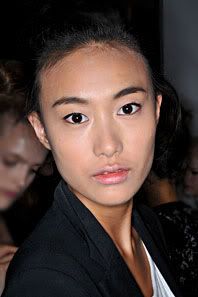 |
Guess what I saw yesterday. I was at the cosmetics store Sephora, and went towards the perfume counter to see what new items they had for the Christmas season. Along the way, I passed an Asian woman, in her mid-twenties, furiously putting on make-up - blush, actually. I watched for a second, as she rubbed on the blush vigorously, and then realized that she was actually putting on the make-up, not just trying it on.
I walked towards her and asked her if she was using her own brush (my question really meant was she putting on the make-up, or was she trying it on). She stopped short, but gave no answer. I walked away, but turned back to see if she continued. She had left, (vanished). Here was another case of an Asian woman using Sephora's make-up for free. I've seen this happen often, where I have to maneuver through Chinese women loudly and arrogantly holding up the make-up and perfume counters, plastering on lipstick or perfume, for free. I know what they're doing, but this was the first time I tested my theory. I was right.
Thursday, October 20, 2011
Cannibals
The blogger who posted the photos below (there are many more at his website) found a recurring theme of death in almost all the photos of the "protestors" at Occupy Denver, and especially cannibalism as in "eat the rich," illustrated with gory (hand-made) signs and t-shirts. He calls it "neo-cannibalism." Of course, "eat the rich" it is a riff off "tax the rich" but it is gruesome and violent nonetheless. The message is that the rich deserve far worse than merely having their money taken away. Eat them, and be done with them!
I've posted some of the photos which I think especially underline this cannibalism theme.
Here's a photo of an overweight (close to obese) couple. I wonder how they got that way?
No-one would run away from this sappy-faced, fanged cannibal, with his make-shift card board sign with all kinds of incoherent "signs," although the skull with the A is pretty obvious.
More like zombies than cannibals.
A nice looking couple. What happened to them? Leftism.
The sign reads: "One day the poor will have nothing to eat but the rich!" Why are they speaking for the poor? They don't look poor to me, just the usual chic poor leftists.
A Somali cab driver is perplexed. But, I don't believe him. Somalis, at least here in Canada, are the most aggressive beneficiaries of government handouts that take from the "rich" whites to give to the "poor" black immigrants.
The Mexican-looking man (El Comandante) may be doing all the talking, but the Aryan-looking man is watching closely.
But this is the most fascinating image, on many levels:
A Sign from Occupy Denver participant
This "protestor" is (mis)quoting Genesis Chapter I, Verse I, the very beginning of our Bible, which says, "In the beginning God created the heaven and the earth" to tell us of his Marxist beginning, which is really about destroying what is already there - the Götterdämmerung - to bring us his utopic world. A new world.
There is no "beginning" in the meaning of his sign, but destruction and end. The true pomposity of people like him becomes evident, when, like Hitler, they plan godlike to recreate a new world after having destroyed this one. Then they deign to create a new one. But out of what? Out of nothing? They won't even be there, if we follow the logic of their ideas (ideology).
I've posted some of the photos which I think especially underline this cannibalism theme.
 |
Here's a photo of an overweight (close to obese) couple. I wonder how they got that way?
 |
No-one would run away from this sappy-faced, fanged cannibal, with his make-shift card board sign with all kinds of incoherent "signs," although the skull with the A is pretty obvious.
 |
More like zombies than cannibals.
 |
A nice looking couple. What happened to them? Leftism.
The sign reads: "One day the poor will have nothing to eat but the rich!" Why are they speaking for the poor? They don't look poor to me, just the usual chic poor leftists.
 |
A Somali cab driver is perplexed. But, I don't believe him. Somalis, at least here in Canada, are the most aggressive beneficiaries of government handouts that take from the "rich" whites to give to the "poor" black immigrants.
 |
The Mexican-looking man (El Comandante) may be doing all the talking, but the Aryan-looking man is watching closely.
But this is the most fascinating image, on many levels:
 |
This "protestor" is (mis)quoting Genesis Chapter I, Verse I, the very beginning of our Bible, which says, "In the beginning God created the heaven and the earth" to tell us of his Marxist beginning, which is really about destroying what is already there - the Götterdämmerung - to bring us his utopic world. A new world.
There is no "beginning" in the meaning of his sign, but destruction and end. The true pomposity of people like him becomes evident, when, like Hitler, they plan godlike to recreate a new world after having destroyed this one. Then they deign to create a new one. But out of what? Out of nothing? They won't even be there, if we follow the logic of their ideas (ideology).
Tuesday, October 18, 2011
Burst of Fall
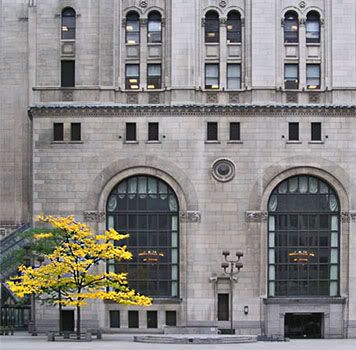 |
This is another in my series of photos of the Canadian Bank of Commerce Building (built between 1929 and 1931) with the Commerce Court behind it. The series includes the gilded ceiling, and the outside court (with the elephant sculpture).
- Gilded Ceiling
- Golden Gilded Ceiling
- Gilded Ceiling slide show
- Pei in the Sky
- Tembo, Mother of Elephants in Downtown Toronto
Sunday, October 16, 2011
"If you try to get rid of religion, you aren't going to get rid of religion"
In a recent post "Sacred days for sacred celebrations" I wrote about a couple's attempt at integrating some kind of holiness into their wedding day by chosing a relatively sacrosanct holiday on which to hold their ceremony despite forfeiting a church ceremony.
Here is what Jim Kalb says about getting rid of religion, and its replacement:
Here is what Jim Kalb says about getting rid of religion, and its replacement:
If you try to get rid of religion, you aren't going to get rid of religion. Instead, you'll get some scheme of attitude and belief that functions like a religion but pretends to be something else and will probably go off in strange directions because nobody's allowed to think about what it really is. In short, you'll get something rather like the Antichrist.
Truth vs. truth
 |
By Nikolai Ge
In my ongoing attempt at understanding liberals, here is a thought:
Liberals are interested in truth, not Truth. And they are willing to lie to attain it.
Country in the City: Pt. II
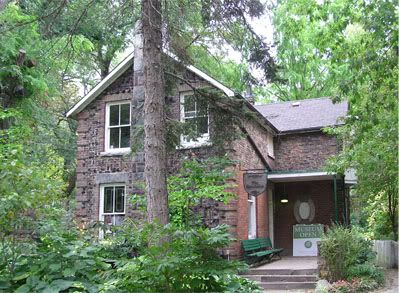 |
[Photo by KPA]
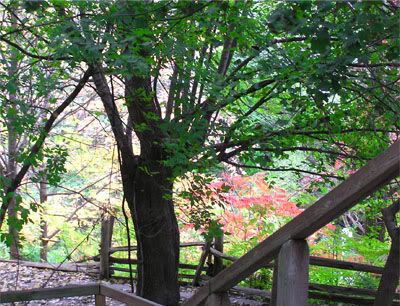 |
[Photo by KPA]
The Cabbagetown/Regent Park Community Museum is a not-for-profit organization that strives to actively collect, preserve and display the history of Cabbagetown and Regent Park from the late 1800s/early 1900s to present day. Using oral histories, artifacts, photographs and printed material, we will present the stories of the local community and place them within the larger, global context...
Presently, the museum has a temporary home at the Riverdale Farm's Residence House. Also known as the Resident Zookeeper's House this two-story building, which stands beside the Meeting House and duck pond; was built in 1902 by prisoners of the Toronto Don Jail. Over the years the building acted as the Zoo Keeper's home, veterinary hospital, and temporary morgue for the Necropolis Cemetery. Today the Residence not only houses some of the Cabbagetown Regent Park Museum's collection, it also functions as a staff building, and is used for a variety of farm- related and community-based programs. [Source: Cabbagetown Regent Park Museum website]
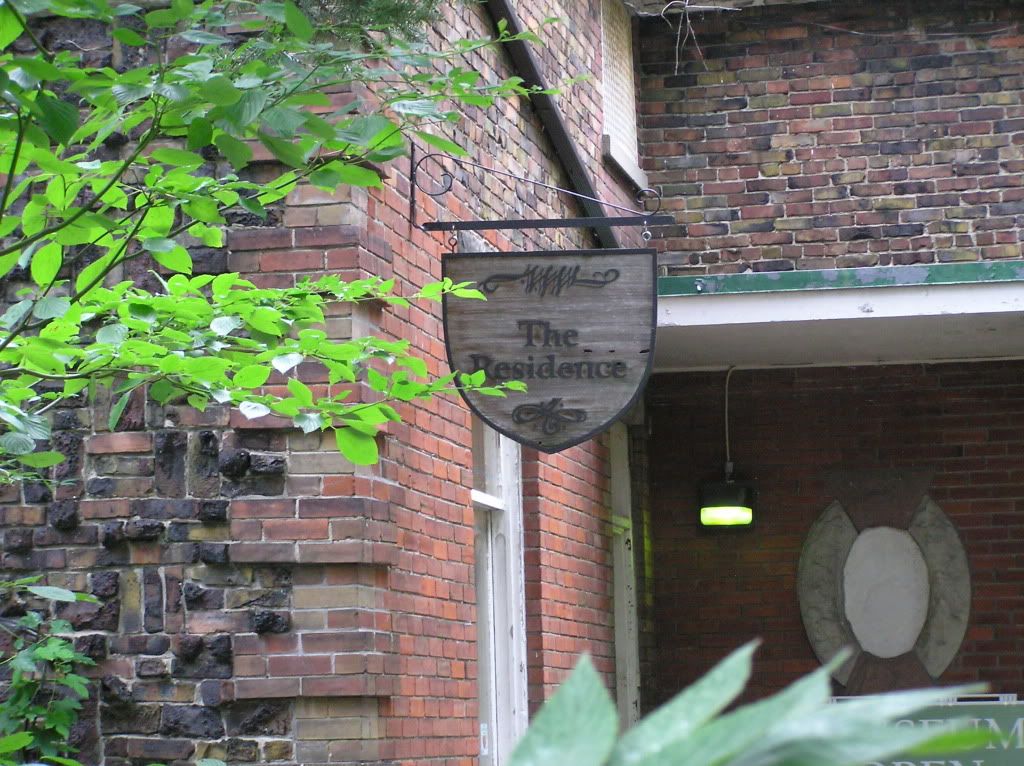 |
 |
[Photos by KPA]
Named for the distinctive sound they make when banged together, clinker bricks are the result of wet bricks placed too close to the fire. The intense heat of coal-burning traditional kilns created a hard, durable brick that often twisted into volcanic shapes and textures. Overbaking produced rich, warm colors as well that ran the gamut from reds, yellows, and oranges to deep, flash-burned browns, purples, and blacks. No two clinker bricks were alike, rendering them trash to brick manufacturers who prized uniformity, but treasure to early modern architects, builders, and homeowners seeking uncommon architectural detail.The Residence now hosts a mini-museum of Cabbagetown artifacts showing the area's social and cultural history.
During the Arts & Crafts era, clinkers were used to accentuate bungalow architecture, creating visual interest in focal points such as chimneys, porch supports, and garden walls. The use of clinkers in English walls during the 19th century was well documented, but Charles and Henry Greene, who incorporated clinkers in their most famous California houses, may have been impressed after seeing the bricks used in buildings near Boston, where both brothers attended MIT. [Source: The Accidental Charm of Clinker Bricks]
Some interesting items from the early 20th century include:
- A pram
- Lace christening clothes
- Photos, badges and other memorabilia of WWI soldiers from Cabbagetown
- Toy Fire Engine
- The history of the area's Fire Department
- A Betty Boop war doll
- Vintage postcards
- Toys and artifacts
Soldier from the 48th Highlander of Canada who lived in Cabbagetown, who served in WWI:
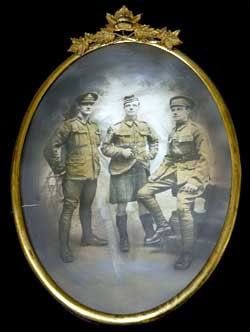 |
on either side, served with the 48th Highlanders
of Canada in WWI
[Source: Cabbagetown Regent Park Museum website ]
The most popular item is the doll house:
 |
dating from the 1870s.
Right: 1983 Second Empire replica dollhouse by J.E.M. Clark
[Source for doll house and house - Cabbagetown Preservation Association Newsletter. Spring 2009, volume 19 issue 1, P.5. - pdf file]
[The] Second Empire Victorian Dollhouse was built in 1983 by Master Craftsman John Edward Morris Clark of Tottenham, Ontario for his younger daughter, Natalie’s tenth birthday. John is also a custom Gun Maker specializing in 18th century flintlock rifles pistols and fowling pieces; and manufactures wooden propellers for vintage aircraft [www.clarkindustries.on.ca]. The dollhouse plans were obtained from a woodcrafter in Massachusetts, USA, and it took John roughly 400-hours to complete. The siding and shingles are made from pine strip wood and tongue depressors. The windows and doors were purchased from The Little Dollhouse Company, Toronto, which is the largest and oldest doll house and miniature store in Canada.
The dollhouse represents the type of home that would have been built in a small town or rural area of Ontario in the 1870s and 1880s. It’s a single family home, made of wood, featuring a striking tower, iron work, porches, and, most distinctively, a steeply sloped “mansard roof.” These are all characteristic features of the Second Empire style that influenced Victorian architecture all across Ontario, Canada, Britain, and, of course, France where the “Second Empire” referred to the reign of Napoleon III.
The Second Empire style was also very influential in Toronto. Above all, the mansard roof identifies these buildings. Second Empire architecture in Toronto, and Cabbagetown - Regent Park, was quite a “grand” style, although we see smaller, but still impressive, examples on our own streets. Originally, most buildings shown here were residences, but they have been transformed into other uses.
[Source - Cabbagetown Preservation Association Newsletter. Spring 2009, volume 19 issue 1, P.5. - pdf file]
Country in the City Pt. I is here.
Saturday, October 15, 2011
Sacred Days for Sacred Celebrations
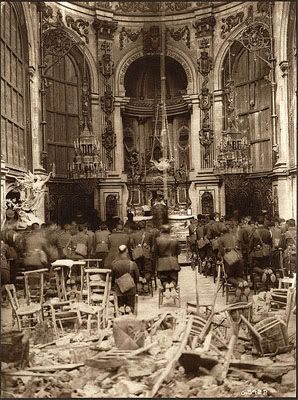 |
being held in the Cambrai Cathedral (Notre-Dame de Grâce chapel)
13 October 1918
[Image from Wikipedia and
the Archives of Ontario Visual Database]
-----------------------------------------------------------------------------------------
I got an invitation to a Fall wedding this past summer, which also involved traveling out to beautiful British Columbia. Everything looked great, including the venue for the wedding, which required flying out to northern B.C., then a ferry ride to the location. I was really looking forward to it, but there was something missing. I turned the invitation upside-down, back and front, looking for this decisive information.
There would be no church service. The wedding would be a "secular" event. I wasn't even sure how the actual wedding vows would be exchanged. I suspect some wedding officiant would be there to perform the "vows."
So, I declined the invitation. I didn't want to participate in one more event that would facilitate what I'm now openly beginning to call evil.
But, the interesting thing was that the wedding was to take place on Thanksgiving week-end. Canadian Thanksgiving Day was last Monday. Thanksgiving Day was set for the second Monday in October, (which also happens to be Columbus Day in the US). It is mostly a secular holiday now, although originally, as proclaimed by the Canadian Parliament in 1957, it was:
A Day of General Thanksgiving to Almighty God for the bountiful harvest with which Canada has been blessed – to be observed on the 2nd Monday in October.Rather than set up a Christian wedding, this couple preferred to latch on to some kind of religious semblance, since although Thanksgiving was originally celebrated with prayers and thanks to God, now more and more people are using its secular motifs.
People cannot do without a higher, transcendental order. They cannot, innately, do without God. Yet, having rejected the one true God, they have to replace him with whatever they find suits their individual (or cultural) life. Thanksgiving became the perfect latch-on for this couple: giving thanks to something, yet with no commitment to God.
It cost me a lot to refuse this invitation. But, it costs more to participate in what they were expecting me to participate in.
Friday, October 14, 2011
Michelle Obama's Gladiator Dress: Korean Variation Pt. II
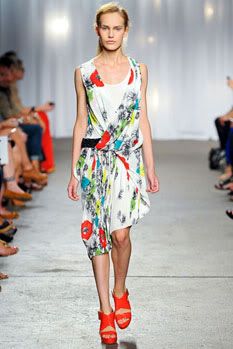 |
Spring 2011 collection
In my previous post on Michelle Obama's gown for the Korean White House state dinner for the Korean president, I wrote that I couldn't find the name of her dress designer. Well, I wasn't far wrong with the title of that blog ("Michelle Obama's Gladiator Dress: Korean Variation"). The Washington Times informs us:
Mrs. Obama wore a striking purple, one-shouldered gown by Korean-born designer Doo-Ri Chung as she and the president welcomed Lee and his wife in the rain. The South Korean first lady, Kim Yoon-ok, wore a traditional hanbok in pink and white.I have to speculate whether Chung copied Peter Soronen's "gladiator dress" for Michelle, since the resemblance of her dress to Soronen's is striking (and this comparison is not a complement).
Here are more of Chung's unspectacular, oddly designed, shapeless clothes (is this an Asian thing? Read my posts on Vera Wang's latest creations here, here, and here). The Washington Times mentions "Korean knotting." Is Chung trying to put that "cultural" element in her designs?
Chung's biography from Wikipedia:
Chung graduated from The New School university's Parsons division with a Bachelor of Fine Arts in Fashion in 1995. After receiving her degree, Chung worked for Geoffrey Beene for six years, rising to the position of head designer. In 2001, Chung started her own firm in the basement of her parents' dry cleaning business. The firm remained there for the next four years.Is this "Asian triumphalism" but on a cultural (multiculutral) rather than a global level?
Chung is best known for her jersey dresses, which have a unique drape. Chung has stated that she has no plans to move away from creating such dresses, as she now has a steady clientele. Chung will introduce a shoe line in fall 2008.
Chung is inspired by Ann Demeulemeester, Martha Graham and Joseph Beuys.
Here are excerpts from Chung's biography on Vogue:
1973 - Doo-Ri Chung born in South Korea.Here is information about the personalities that inspire Chung:
1977 - Chung’s family immigrates to America. She is raised in Ramsey, New Jersey.
1995 - Graduates from Parsons, winning the school’s Designer of the Year award. Her critics are Donna Karan and Stanley Herman. Briefly works for Banana Republic, designing menswear. August: Particpates in Paper magazine’s Fashion Mobile talent search, through which she meets Geoffrey Beene, for whom she will work for six years, rising at his firm from assistant to head designer. (Alber Elbaz also will be employed by Beene for some of that time.)
2003 - Makes her formal debut for fall 2003. May: Tells Vogue: "Draping with stretch is what I know best." December: Receives the Ecco Domani Fashion Foundation award.
2008 - February: "Unwittingly, my signature is the way I drape a jersey dress, and I do that each season," Chung tells Vogue. "I think I’ve established a clientele, and I don’t want to alienate it. I’m more interested in evolving what I already do." Launches footwear for fall. "Shoes are a lot harder than I thought, but making them is actually similar to the way I make clothes because they’re so three-dimensional."
- Ann Demeulemeester
Ann Demeulemeester...draws much of her inspiration from the androgynous singer, Patti Smith. Currently, she is working on a clothing line inspired by Jackson Pollock.
Demeulemeester is married to photographer Patrick Robyn and has a son, Viktor. The couple live in Antwerp, in the only house in Belgium designed by Le Corbusier.
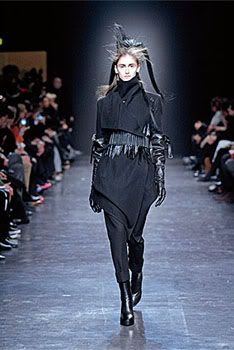 |
Spring 2011 collection
- Joseph Beuys
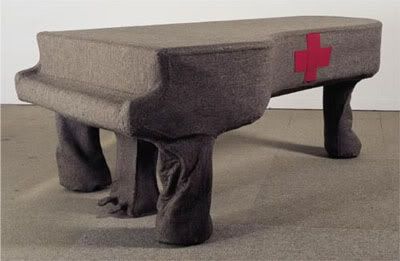 |
By Joseph Beuys
Patti Smith, Jackson Pollock, Le Corbusier (here is Theodore Darlymple on Le Corbusier; here is my blog post on him), Ann Demeulemeester, Joseph Beuys? That says it all.
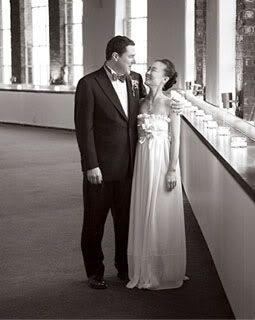 |
Even Chung's wedding dress doesn't escape her "oddly designed, shapeless" style that I describe above.
Michelle Obama's Gladiator Dress: Korean Variation
 |
The mischievous Drudge has a photo of Obama and Michelle at the state dinner for South Korea's President and his wife on his site today, which he headlines "Skin is in!" referring, of course, to Michelle's (yet again) bare arms. It looks like Michelle has lost some weight (is she following the dietary program from her "Let's Move" project on childhood obesity?). The dress she's wearing looks like a recycled version of the "gladiator" dress she wore at the May 19, 2010 state dinner for Mexico's president, showing (off) her then Amazon muscles. The 2010 gown was designed by Peter Soronen. This one also looks like one of his creations, but I cannot find any reference to it online. Her muscles are subdued, her face is more gaunt, and she seems generally thinner.
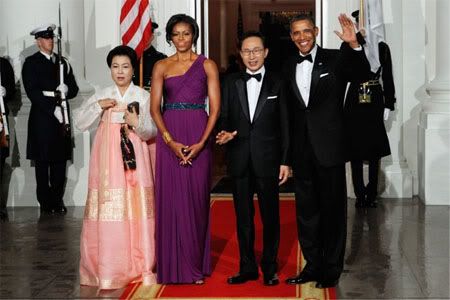 |
Wednesday, October 12, 2011
Chaz Bono Still on DWTS
 |
I'm surprised that a show such as Dancing With the Stars exists, with traditional dances like the waltz, and couple's dances like the foxtrot and the quickstep, and other intricate dances like the jive and the jitterbug. Hip-hop has not made it on the list. I keep getting optimistic that our contemporary culture yearns for beautiful things. The fact that young dancers like the Hough siblings (see below) are dedicating their dance careers to such types of dances, and that a show like DWTS exists, is perhaps proof of this optimism.
Still, this season's DWTS seems to be a repository of personalities we might shun under normal circumstances, but who now receive our weekly attention. That is of course true of most TV programs.
I've already written about Chaz Bono on DWTS, who keeps making it to another week of competition, and who made it through to next week by punching into the air to the theme song of Rocky.
I neglected to mention two other personalities.
The first, although it is hardly his fault, is Iraq war veteran J.R. Martinez who received burns to 40% of his body (including his face) when his truck went over a landmine. Cosmetic surgery and make-up does improve his facial scars, but I'm sure at one point wounded soldiers were more modest, and more retiring, about their injuries.
The other is the homosexual presenter of the fashion makeover show "Queer Eyes for the Straight Guy" Carson Kressley. There seems to be a common agreement that gay men are natural aesthetes. The history of aesthetics (art) is filled with straight men. Perhaps the few homosexuals we encounter are given unusual publicity, perhaps by gay art historians and the like, for their homosexuality.
Kressley's "gay flair" is so noticeable, and ever-present, that it overshadows (and cancels out) his other positive abilities.
On another note, half (of the twelve) professional dancers are Eastern European. This week, I noticed that two, Tony Dovolani and Maksim Chmerkovsky, were unduly harsh on their all-American partners, Chynna Phillips and Hope Solo (their bios are here). These are normally confident and outspoken women. They expected to participate in the dance creations and routines, rather than simply follow instructions. The men made it clear that they were the bosses, at times even walking out of rehearsals when they felt the women weren't allowing that to happen.
In a desperate bid, the women appealed to the men's "pride" by buttressing their egos with admiring words and self-effacing attitudes. It was awkward, and embarrassing to watch. Chynna Phillips got low scores and was sent home last night anyway. At her exit, a glint of regret escaped from her hardened face, as though she was angry at having succumbed to her partner's bully tactics. Next time, she'll know what to do when "culture" gets in the way.
On a positive note, there are the talented siblings Derek and Julianne Hough, who are the real stars of DWTS. I've written about Derek before, comparing him to Fred Astair. Julianne could be his Ginger Rogers. This video is of Derek and Julianne dancing together.
Now, let's just all vote next time and get rid of the "Chaz Bono factor" (i.e. the "freak show factor").
Tuesday, October 11, 2011
RE: FYI, Chaz on DWTS
 |
The ugly, creepy Chaz Bono is still in the running for Dancing With the Stars (DWTS). I've written here that it keeps getting voted back on the show for the freak factor. Teary-eyed Cher was watching, and applauding, in the audience last night. Like I said before, the emotional Cher, after angrily rejecting her daughter's sex change, embraced the new Chaz, preferring to have something to nothing. "Sex change" is actually a false description, since the procedure is incomplete. Chaz has informed us that if it has a penis, there is no guarantee that it will have enjoyable sex, so better to leave its female parts below. Sorry for the sordid details, but like I've said before, it is better to know our enemies since the day of reckoning is surely not far off.
Monday, October 10, 2011
Style in New York - Part II
Below are screen shots of a building in New York, where Sandra Bullock's character from Two Weeks Notice (which I've discussed in this post) goes to have an interview after quitting the demanding job of assistant-to-the-lawyer/secretary/wife-in role-only/nanny to Hugh Grant's character.
The building has a beautiful stained-glass ceiling, which the camera briefly twirls around as it follows Bullock and the lawyer who interviewed her come down the staircase. On the wall behind the banister are three imposing portraits of what look like Lowell, Hanes and Richards, names which are inscribed on tasteful steel in very large lettering below the portraits. These stern gentlemen quite likely run the firm, or are its founders, or are involved with some important contribution.
The whole film was shot in New York, at the urgings of Bullock:
I bought the DVD (yes, that's how much I liked it, plus it was on sale), and have made screen shots of the stained-glass ceiling, which I've posted below.
The film is worth renting/buying. It has some good shots of New York, and Bullock and Grant are witty personalities, who are both very good actors. And as I've mentioned before, there are also some unexpectedly lovely scenes.
[Images are screen shots from the film Two Weeks Notice]
The building has a beautiful stained-glass ceiling, which the camera briefly twirls around as it follows Bullock and the lawyer who interviewed her come down the staircase. On the wall behind the banister are three imposing portraits of what look like Lowell, Hanes and Richards, names which are inscribed on tasteful steel in very large lettering below the portraits. These stern gentlemen quite likely run the firm, or are its founders, or are involved with some important contribution.
The whole film was shot in New York, at the urgings of Bullock:
Shortly after the events of September 11th, Sandra Bullock, also the film's producer, urged that the film be shot entirely in New York to marshal support for the City and its production industry. No online "film location" website could give me any information on the building.I've tried looking online for the building with these stained-glass ceilings, but I've had no luck so far. The film credits don't mention them, and other sources lead me to Grant's law firm building (Lucent Technologies building), and the Sky Studio in Greenwich Village which serves as the hotel in which Grant lives ("I own the hotel, and I live there. My life is very much like Monopoly." - I thought this was another funny line in the frequently funny movie, since surely jail must be one of the possibilities of his life of monopoly), but not to this particular building.
I bought the DVD (yes, that's how much I liked it, plus it was on sale), and have made screen shots of the stained-glass ceiling, which I've posted below.
The film is worth renting/buying. It has some good shots of New York, and Bullock and Grant are witty personalities, who are both very good actors. And as I've mentioned before, there are also some unexpectedly lovely scenes.
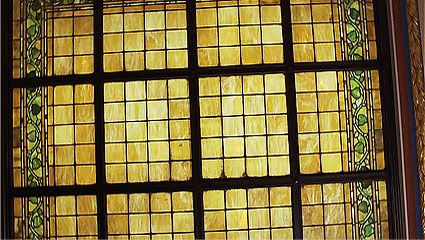 |
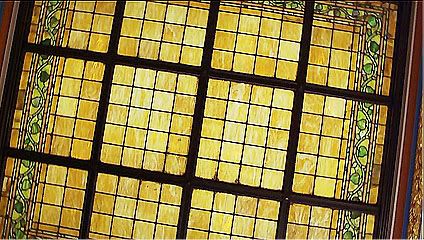 |
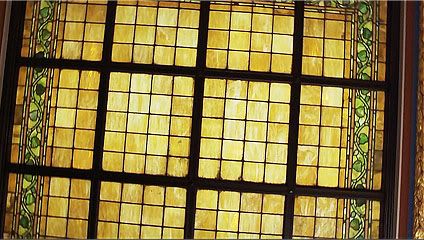 |
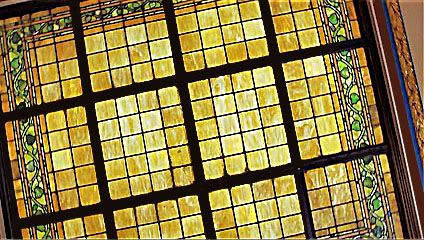 |
[Images are screen shots from the film Two Weeks Notice]
Style in New York - Part I
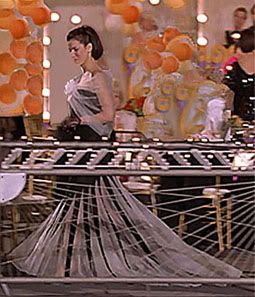 |
costume designer Gary Jones at a Charity Ball
on her boss's - Hugh Grant's - yacht
I've watched Sandra Bullock's Two Weeks Notice a few times, mostly because I like her, and I think she's a good actress (although contemporary actresses basically play variations of themselves, and do not venture into real role playing), and also for the scenes of New York City. Hugh Grant, is the upper-class Englishman in a high profile job (a law firm head) in NYC - a role which actually fits him better than it sounds.
First Sandra Bullock:
Here's a lovely dress that she wore to a charity ball on Grant's yacht (yes, poor children are better remembered while wining and dining in expensive and beautiful surroundings).
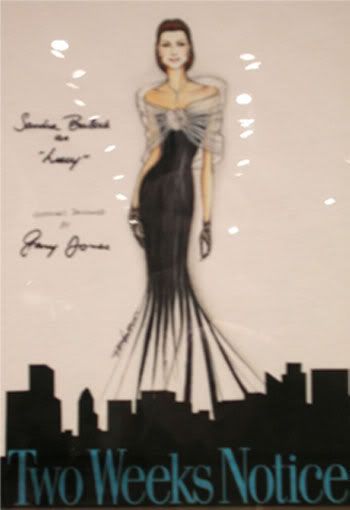 |
According to this website, here's Jones's creative process for this dress:
In creating Lucy’s wardrobe for the gala sequence, costume designer Gary Jones designed a striking black and white gown inspired by vintage Yves St. Laurent and Valentino. "We wanted a classic look that meshed with Lucy’s professional style: feminine but fitted," says Jones, who took further inspiration from films of the 1930s and 40s, as well as the cinematic style of Audrey Hepburn and Katherine Hepburn.This blogger claims that another inspiration was Grace Kelly's dress in Rear Window:
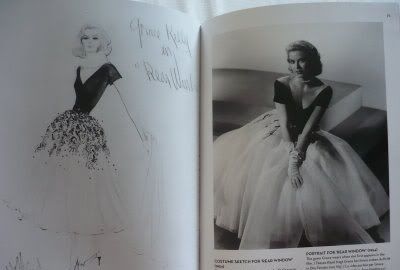 |
And the dress does live up to its mentors: Audrey Hepburn, Valentino, Grace Kelly. As does Sandra Bullock.
Sunday, October 9, 2011
Country in the City
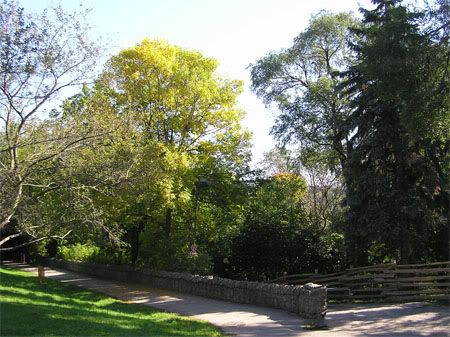 |
 |
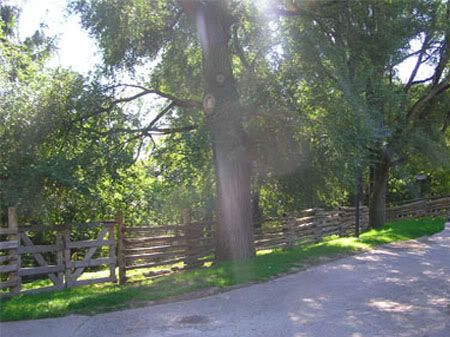 |
The Riverdale Farm is only about thirty minutes walk from downtown Toronto, and close to the Cabbagetown neighborhood (which was an Irish immigrant enclave during the late 19th century - hardy cabbages grew in the front gardens). It became a prestigious neighborhood in the mid-twentieth century. It feels like we're completely immersed in the country.
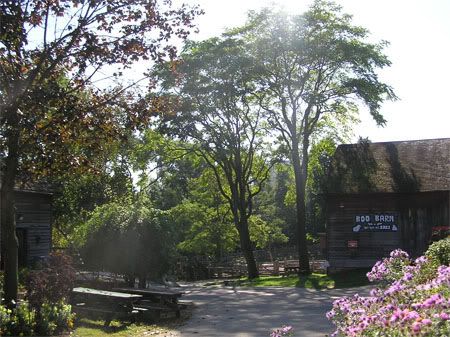 |
A "Boo Barn" in time for Halloween. I'm always amazed that flowers still
bloom this late past the summer.
[Photos by KPA]
Save the Farm
Thursday, October 6, 2011
Jews, Hebrews, and David Yeagley
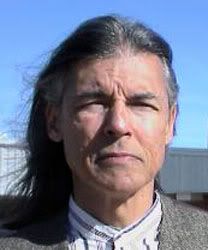 |
He has excerpted and commented on
my blog post Indians Will Be Indians.
I also participated in his forums.
David Yeagley, the American Indian from Oklahoma, who writes for Vdare, Frontpage Magazine and other venues, has an interesting article at his website on the meaning of Jewishness (if that is a proper term). I think he correctly writes that there is no distinguishing the Jewish ethnicity from the Jewish religion.
Christians are united by their belief in Christ, yet they may come from groups as diverse as the Inuit in northern Canada to the Ethiopians in the horn of Africa.
Yet, there is no separating the Jewish ethnicity - their physical and physiological make-up - from the Jewish spirituality. One can only be a Jew through lineage!
This is a hard responsibility to bear. Once a Jew, always a Jew.
I wonder why God made this particular decision, to combine the ethnic with the spiritual? I wonder why he let Christians rule the world, so to speak, while confining Jews, technically, to the tiny parcel of the land of Israel, which they can only enter as Jews?
Yet look how powerful the Jews are, in people's psyche, at least. Anti-Semitism is the strangest, most virulent, type of hate for a group of people. I don't think even different races (blacks or whites) can hate each other as much as the hate directed at Jews.
I think the strength of this hate indicates the strength of God's association with the Jews. The love of God is viciously, jealously, demanded by anti-Semites, however atheist they may be. "Why don't you love us as much as you do the Jews?!"
Perhaps love is not the word, since God loves us all, sinners and saints, Jews and Gentiles, believers and atheists, alike. He might favor some more than others (but that surely is a difficult call, since more is expected of those favored), but love is another thing.
Perhaps what God is showing us is that he is a particular God, with a particular history, whose trajectories we can follow through these people he has anointed. If he can love them, follow them, chastise them, reward them, and grant them long life and prosperity, how can we doubt that he will not do the same for us, collectively (of whatever ethnicity or nationality we are) and individually?
Perhaps what anti-Semites are projecting is their fears and insecurities, that they may not be up to the standards that God expects from us (from them), and thus they blame (some to the extent of destruction) the people he has placed before us as examples, using them as scapegoats.
There is a horrible thesis that God allowed the Holocaust to occur because the European (and especially the German) Jews had become too distanced from him. In their tremendous success, they were moving away and apart from him. He had to show them that he is God, after all, and that they (we) are at his mercy.
"Cultural" Jews are an interesting phenomenon. They want the best of all worlds: prestige as Jews (through their good works), and some kind of elevated spiritual identity: We Are Jews!
This arrogant self-elevation that is observed by Jews in our era may be what their diabolical enemies are waiting for. Without God on their side, do they really think they will survive this one? So, I think the best recourse for Jews is to be true Jews.
Wednesday, October 5, 2011
Talking to Dogs
 |
I cannot hold it against the dog for being so high up in our social evolutionary scale. His Canadian master has deemed him supreme. Still, Canadian dogs are friendly and playful, and wag their tails (if they have them) at the drop of a hat, until they almost drop off. They have been taught to be polite.
I've already befriended six in my neighborhood: a golden-colored, pretty bull terrier called Paris who responds with high velocity wagging when I says "Hi Paris!"; Paris's friend, an elderly beagle called Maggie; a Newfie giant who gallops to me for a greeting; Noah (some name to live up to!), a rambunctious tan Irish terrier who finds a bare spot on my hand to lick (how does he find it, in these days when all skin is bundled up for the cold fall?), then stands quietly beside me for a pat; Bodhi the bull dog with no tail, who gyrates his derriere to say "HELLO!"; and a black Irish terrier (called Shadow) who, like his tan cousin, affectionately stands close by to get patted on his sturdy back, then walks behind me as though he understand what his name requires him to do.
The owners are all a little alarmed at this, and some actually pull their dogs subtly away. "Who is this person who magically attracts our beloved pet?" I think dogs respond to a friendly voice. And their limited vocabulary includes "Hello" and "Hi" to which, especially these being polite (and Canadian), they respond.
Squirrels also stop short, and stare, for a few brief seconds at the human who interrupts their busy nut-collecting activity with some human talk.
Tuesday, October 4, 2011
Tembo, Mother of Elephants in Downtown Toronto
 |
I suppose it is proper that an African elephant acquire an African name, even in the concrete jungle of downtown Toronto, and notwithstanding the financial references. Tembo in Swahili means "elephant." Still, Hudson could have come up with a more original name, like Rudyard Kipling's array of characters in The Jungle Book.
The sculpture is in the Commerce Court courtyard of the financial district, near the TD Centre, on loan from the L.L. Odette Foundation.
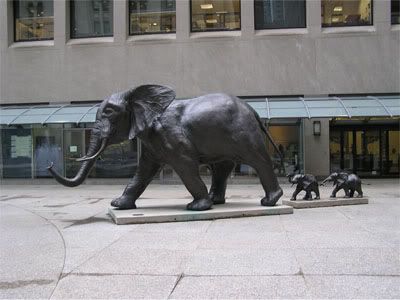 |
Bronze, three pieces:
Mother elephant 9'1" high by 16' long
Two babies 2 '3" high by 4' wide
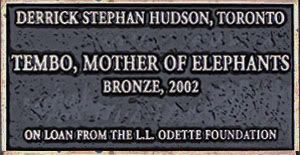 |
The Artist, Derrick Stephan Hudson was born in the UK and moved to Canada as a child. He earned a Bachelor of History Degree before completing his studies at the Ontario College of Art and Design. Hudson’s work features wildlife forms in bronze, silver and stone and are included in private collections in Canada, the United States and the United Kingdom. (Source)Here's what the above link says about Hudson's technique:
Starting as a 20cm high model, Tembo was digitized. The 3D model was then scaled to allow the foundry to produce the 4 meter Bronze. Steinbichler White Light and laser Digitizing was the best tool to ensure that all of the necessary details were captured.The elephants are in the financial district of Toronto (near the TD Centre and the cow sculptures). I've tried to find out more about elephant symbolism in finance, but this is the best I could come up with, from Investopedia:
Combining white light pattern projection with CCD imaging technology, the Steinbichler system can capture millions of points to create multiple “point cloud” images. Using Poly Works Modeler software, a complete 3D point cloud model can then be accurately aligned and built. This 3D point cloud can then be polygonized for rapid viewing or rapid prototyping.
Tembo, a family of African elephants, cast at MST Bronze in Toronto, reflect the strength and loyalty of a mother for her children. The massive mother elephant weighs almost as much as 80 people or six automobiles and is one of the largest bronze elephants in the world.
Think of a swimming pool: if an elephant steps into the pool (buys into a position), the water level (stock price) increases; if the elephant gets out of the pool (sells a position), the water level (stock price) decreases. In comparison to the elephant's influence on stock prices, the effect of an individual investor is more like that of a mouse.And here:
Examples of elephants are professionally managed entities like mutual funds, pension plans, banks and insurance companies.
Contrarian investors specialize in doing the opposite of the elephants, that is, buying when institutions are selling, and selling when institutions are buying.
"How to Track the Market's "Big Money" Elephants":[Photos by KPA]
The stock market is dominated by large money managers... folks who run pension funds, insurance funds, mutual funds, and hedge funds.
Many of these managers control billions of dollars in client assets... and when they decide to enter or exit a position, they can't do it over just a few days. They have to spread their buying over months. They even have to hire people whose main job is to determine the best way to plow big money into individual stocks.
These big money managers are the "elephants" in the stock market. They create the huge moves that become market trends. And you can track elephant behavior with trading volume. [Continued]
Monday, October 3, 2011
Golden Gilded Ceiling
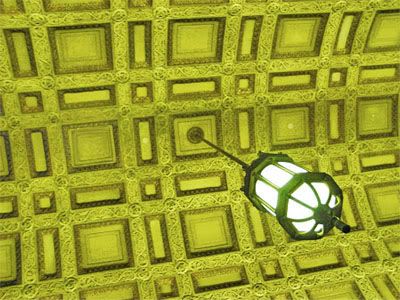 |
on King Street East
[Photo by KPA]
The above photo is another in my series of the "Gilded Ceilings" of buildings in the downtown skyscrapers, many of which were built at the turn of the last (20th) century. This one is in a different section of the Canadian Imperial Bank of Commerce (CIBC) building. It is outside of the actual banking area, and right above the elevators.
Here is the ceiling which is in the lobby area of the CIBC,which I took a couple of months ago.